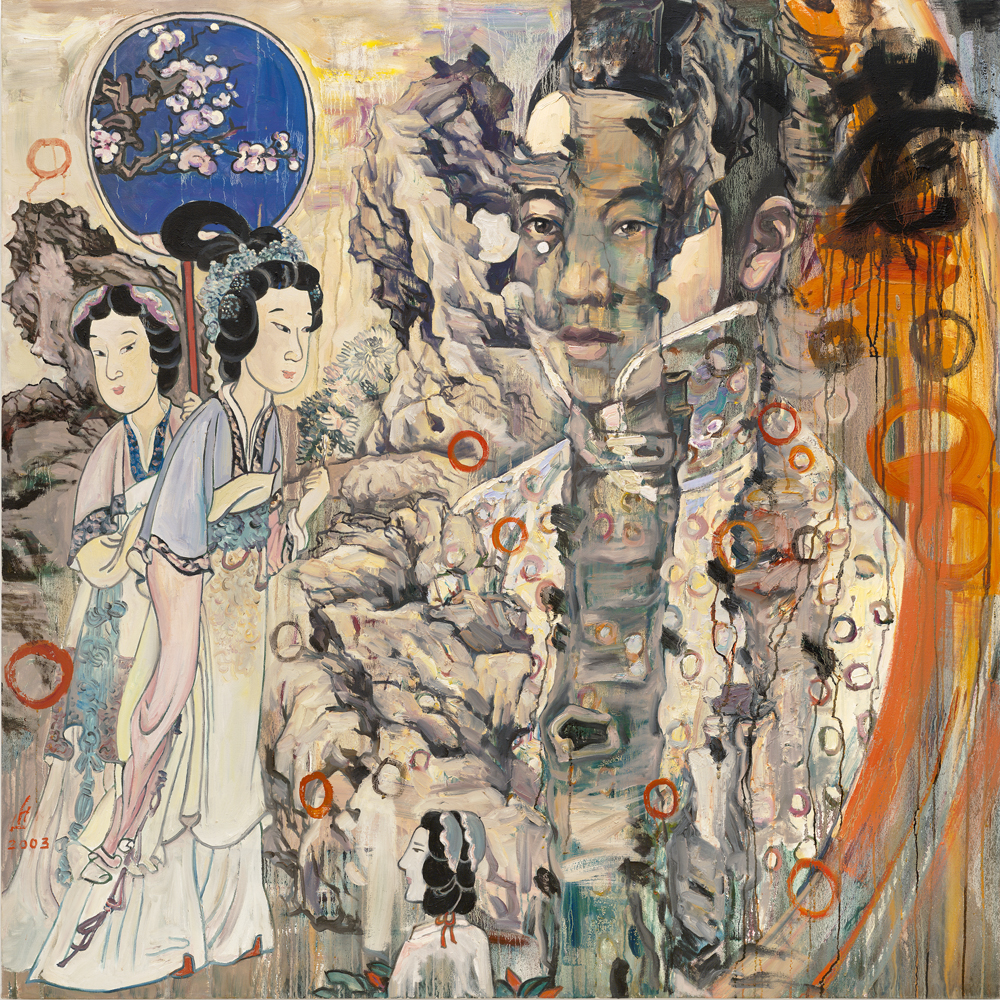Artwork Description
Hung Liu – Garden Scene
Dimensions: 60 x 60″ finished size / 60 x 60″ unframed
Year: 2003
Medium: oil on canvas
In Hung Liu’s Garden Scene, stylized depictions of two women stroll though a garden at the base of a mountain. This part of the painting is a nod to classic Qing Dynasty style which was clearly intended for the male gaze. One woman appears to be holding chrysanthemums and is followed by another woman wielding a large fan adorned with cherry blossoms. This fan is not used for relieving summer heat–it is emblazoned with artistic symbolism of the social status of the user. In Chinese culture, the cherry blossom is a symbol of love and is associated with female beauty and sexual accessibility. The chrysanthemum blooms in bright colors during chilly autumn, a time when most flowers wither. During their blooming season, they face coldness and a tough environment, yet they bloom splendidly without attempting to compete with other flowers, speaking to the woman’s vitality, enduring beauty, and tenacity. The backdrop of this scene reveals a young woman seemingly embedded in the mountain and surrounding scenery. She is seen and unseen, and holds memory for the reality of history behind the idealized representations of the women in the foreground. It is not a stretch to interpret this symbolism and scene as Liu’s representation of the struggle not only in these women’s lives, but as a shared history of women throughout time.
-Shastyn Blomquist, Director
Turner Carroll Gallery
Liu is known for politically charged documentary images of Chinese women and children that are imbued with the weight of memory and the passage of time. Washes and drips dissolve harsh lines and borders. Some areas of the paintings are dreamlike, allowing viewers to make their own associations. Her large Garden Scene (2003, oil on canvas), which is featured in Burned, feels like a mural. One set of images gives way to another set, and that set to another. On the left are the figures of two traditional Chinese women. Turner Carroll says they represent a socially acceptable idea of femininity, and she points out their bound feet in little red slippers. The face of a preternaturally solemn young girl rises diagonally above them, as if from a mountain, but upon closer inspection the rocky terrain is actually an embroidered silk jacket that she is wearing.
Unlike Truong and Lundy, Liu’s use of fire is symbolic. An orange wash of flame sweeps up the right side of Garden Scene. Turner Carroll explains a Chinese cultural belief in which the spirits of the dead are forced to wander if they are not called home by a loved one within a certain amount of time. Liu paints portraits of prostitutes that she found in photographs, she adds. “She’s painting the same people over and over, the same 20 people. In doing that, she’s inviting the people whose lives were destroyed, who were never called back, into her paintings to metaphorically recreate them. The fire here is the fire of reincarnation: not physical reincarnation — but reincarnation of memory.”
-Jennifer Levin, Pasatiempo

